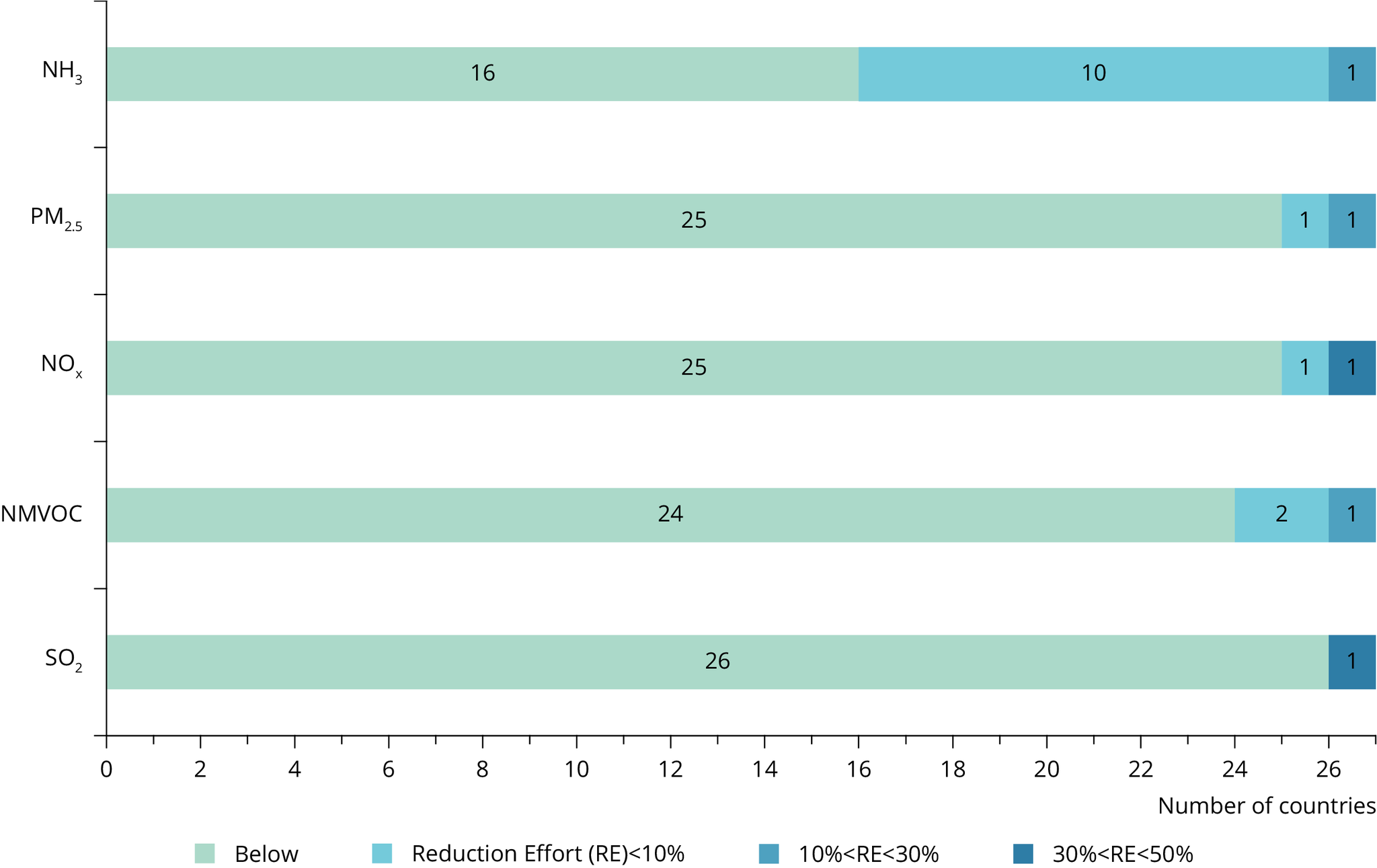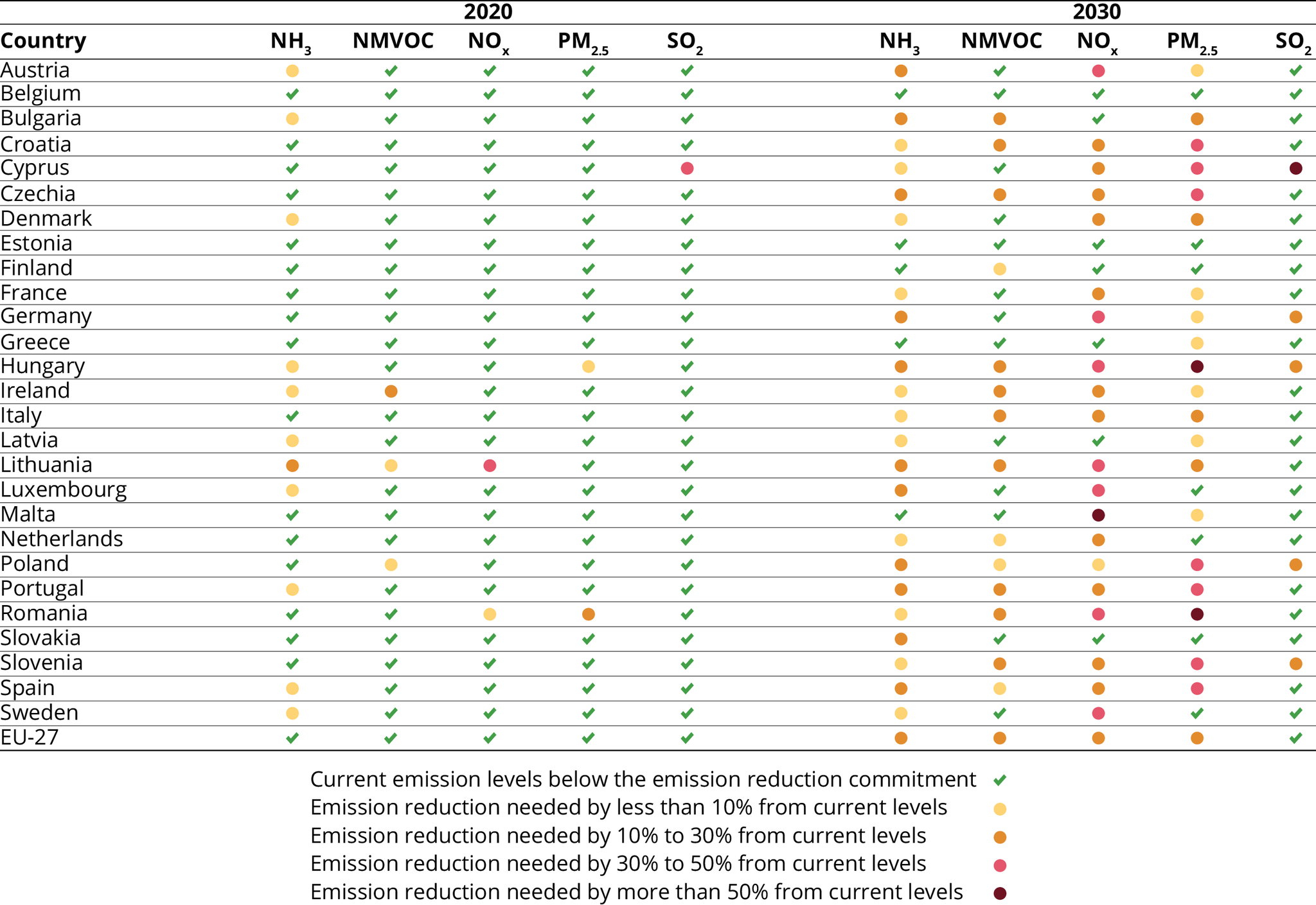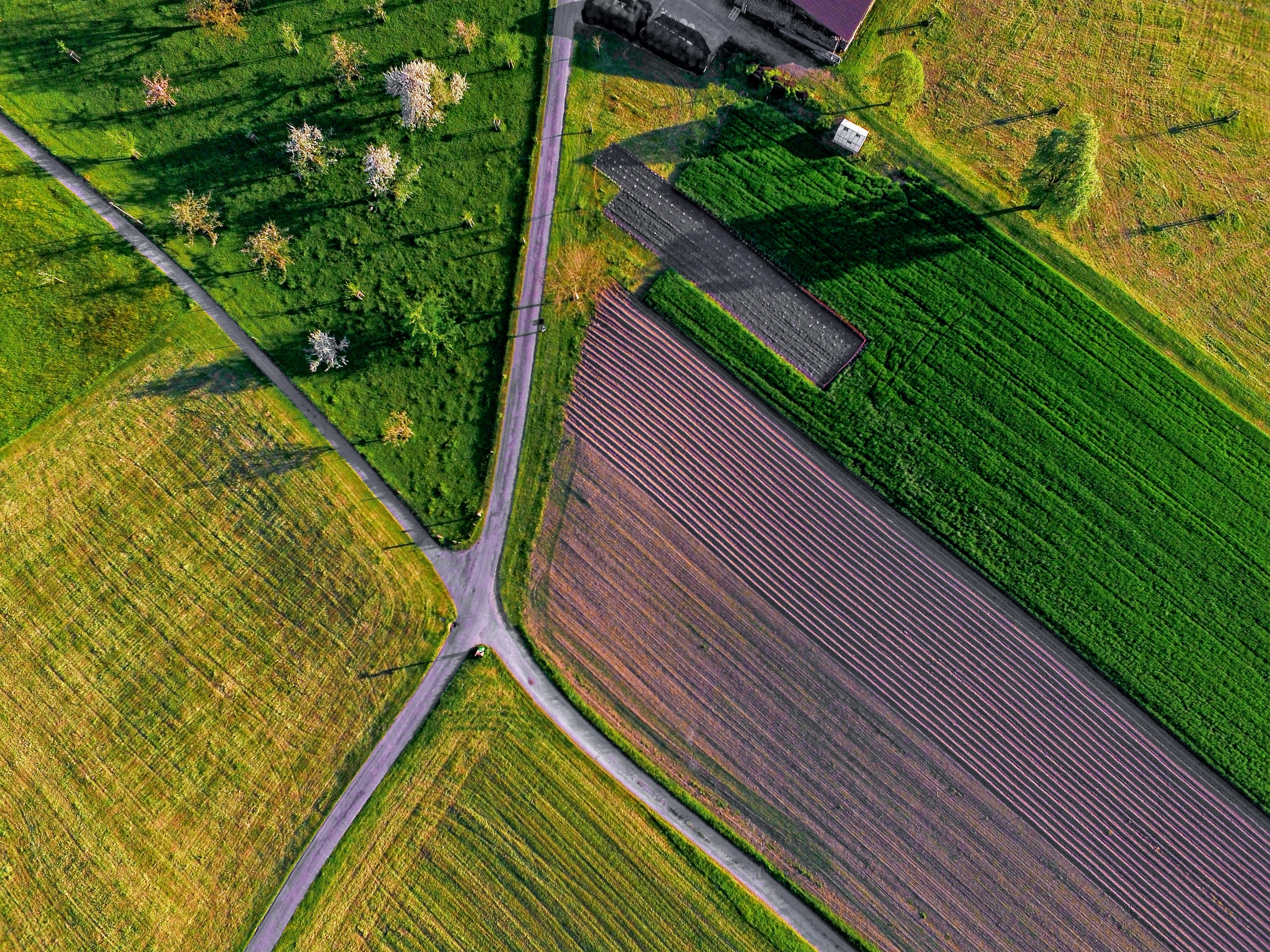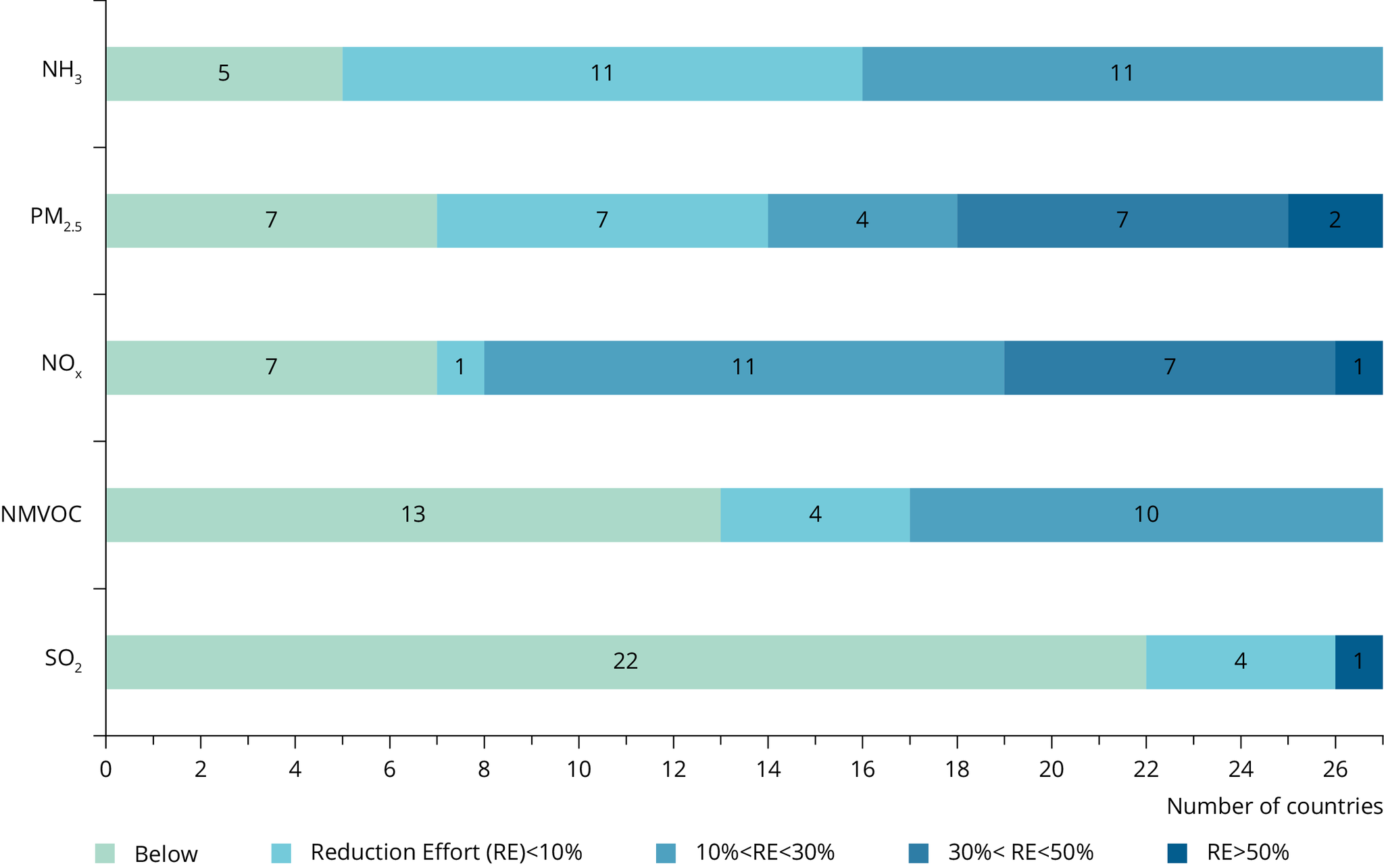Progress towards the emission reduction commitments
Under the National Emission reduction Commitments Directive, the year 2020 saw a transition to a new, more ambitious set of national emission targets. Until the end of 2019, emission ceilings set in 2010 were applicable for four pollutants, namely nitrogen oxides (NOx), non-methane volatile organic compounds (NMVOCs), ammonia (NH3) and sulphur dioxide (SO2) (EU, 2016). From 2020 to 2029, more ambitious emission reduction commitments apply, with even more ambitious commitments due to apply from 2030 onward.
The analysis presented here is based on the latest air pollutant emission inventory data, as reported by Member States in February 2022. It constituted the first opportunity to assess emission reduction performance against the 2020-29 emission reduction commitments. Member States have reported annual emission inventory information since 1990 — or in the case of fine particulate matter (PM2.5) since 2000 —up to two years before the year of submission. The briefing assesses the emission reductions required by Member States to meet their emission reduction commitments for 2020-2029 and presents the reduction effort still needed as a percentage of their 2020 emission levels. Finally, it assesses progress towards the more stringent national emission reduction commitments set for 2030 and beyond.
The National Emission reduction Commitments (NEC) directive sets national commitments to reduce emissions for five pollutants that have significant negative impacts on human health and the environment, namely NOx, NMVOCs, NH3, SO2 and PM2.5. It is one of the legislative instruments supporting delivery of the zero pollution ambition for a toxic-free environment announced in the European Green Deal and is particularly critical to delivering on the 2030 targets related to air pollution under the zero pollution action plan (EC, 2021a) Those targets aim to reduce the number of premature deaths caused by air pollution by 55% and the EU ecosystems where air pollution threatens biodiversity by 25%, in both cases compared to 2005 levels. To achieve these targets, it will be vital that EU Member States meet their respective emission reduction commitments set for 2020-2029 and for 2030 onwards.
Under the NEC Directive, Member States are obliged to draw up and implement national air pollution control programmes (NAPCPs), including measures to reduce emissions from relevant sectors in order to meet national emission reduction commitments and to contribute to improving air quality. Member States should aim to ensure that their emission levels fall on a straight line from 2020 to 2025. In addition, from 2025 the emissions trajectory must become a linear reduction and not affect any emission reduction commitment set for 2030 and beyond. If the reductions in Member States’ emissions are not linear, then the reasons should be set out in the NAPCPs.
The European Climate Law aims to achieve net zero emissions of greenhouse gases, by cutting emissions of such gases, investing in green technologies and protecting the natural environment (EU, 2021). Ensuring consistency between Member States’ national energy and climate plans (NECP) and their NAPCPs can increase the reduction in emissions of both air pollutants and greenhouse gases across the energy, industrial, transport and agricultural sectors.
Status of achieving the 2020-2029 emission reduction commitments under the NEC Directive
In 2020, 13 Member States achieved the emission reduction commitments set for the period 2020-2029 for all five key pollutants.
Figure 1 presents the number of Member States currently meeting their national reduction commitments for the five key pollutants for 2020-2029. It also shows the number of Member States that need to reduce their 2020 emission levels by less than 10%, 10%-30%, 30%-50%, and more than 50% to meet their commitments.

Note: This information is based on data provided by Member States, not yet checked by the European Commission. The numbers are subject to change in relation to the results of the NEC directive inventory review.
More info...
State of play of achievement of the 2020-2029 emission reduction commitments by pollutant for 2020:
- For NH3, 16 Member States met their commitments in 2020, while 11 Member States must still reduce their emissions.
- For NMVOC, 24 Member States met their commitments in 2020, while three Member States must still reduce their emissions.
- For NOX, 25 Member States met their commitments in 2020, while two Member States must still reduce their emissions.
- PM2.5, 25 Member States met their commitments in 2020, while two Member States must still reduce their emissions.
- For SO2, 26 Member States met their commitments in 2020, while one Member State must still reduce its emissions.
While all but one Member State successfully met its SO2 emission reduction commitments, continued and enhanced efforts are needed to bring down ammonia emissions, with 40% of Member States exceeding their respective reduction commitments in 2020.
Efforts needed to meet national emission reduction commitments for 2020-2029
Despite an overall downward trend in emissions, further effort is required at Member State level to achieve the national emission reduction commitments set for the period 2020-2029. Fourteen Member States failed to meet their emission reduction commitments in 2020 for at least one of the five key air pollutants.
Table 1 presents the percentage reductions on 2020 emission levels required for Member States to reach their 2020-2029 and 2030 emission reduction commitments. The required reduction in emissions is calculated as the percentage difference between the 2020 reported emissions and the emission reduction commitments for 2020-2029 and for 2030 onwards.
Member States are divided into five groups:
- Member States where current emission levels fulfil their emission reduction commitment
- Member States that need to reduce emissions by up to 10%
- Member States that need to reduce emissions by 10% to less than 30%
- Member States that need to reduce emissions by 30% to less than 50%
- Member States that need to reduce emissions by more than 50%.

Note: 1This information is based on data provided by Member States, not yet checked by the European Commission. The numbers are subject to change in relation to the results of the NEC directive inventory review.
2The NEC directive (Article 5) establishes a process that allows Member States to ‘adjust’ their emission inventories downwards for compliance checking. This can take place when the failure to comply with the national emission reduction commitments is the result of Member States having applied improved emission inventory methods that have been updated in accordance with the latest scientific knowledge having become available since the reduction commitments were originally set. Ireland has submitted a flexibility application in 2022 for an inventory adjustment in relation to NMVOC. This application is not taken into account in this current assessment. If approved, it could bring Ireland into compliance for NMVOC.
More info...
Ammonia
Eleven Member States will have to further reduce emissions of NH3 to meet their 2020-2029 national emission reduction commitments. As shown in Table 1, Lithuania needs to reduce its emissions by 12% against 2020 levels, while 10 Member States need to reduce NH3 emissions by up to 10%. The principal source of NH3 emissions is agriculture, a sector that was less affected by the COVID-19 lockdown restrictions, implying that 2020 emissions remained relatively stable.
Looking back, in many countries NH3 emissions have decreased only slightly, or in some cases increased, since 2005.
Emissions of NH3 contribute to the formation of PM2.5, the main air pollutant driving premature death in EU-27 Member States. Reducing emissions of NH3 is critical to achieving the zero pollution targets of reducing the number of premature deaths caused by air pollution by 55% and reducing by 25% the EU ecosystems where air pollution threatens biodiversity. Recognising the important contribution that agriculture makes to NH3 emissions, Member States should include more measures applicable to the agricultural sector in their national air pollution control programmes (NAPCPs). The next submission of the revised NAPCPs is due in 2023, providing an opportunity for actions to reduce emissions of NH3 focused on the agricultural sector, such as good practice for housing and feeding livestock, storing manure and spreading it on land, and the sustainable use of fertilisers.
Non-methane volatile organic compounds
Three Member States need to reduce their NMVOC emissions to meet their 2020-2029 national emission reduction commitments. Lithuania and Poland need to reduce emissions by up to 10%, while Ireland needs an 11% reduction.
The manufacturing and extractive industry sector is the main source of NMVOC emissions. The Commission has made a proposal for revised EU rules on industrial emissions, stressing that new technologies or production processes can reduce emissions of key air pollutants and greenhouse gases simultaneously.
Nitrogen oxides
Two Member States need to reduce their NOx emissions to meet their 2020-2029 national emission reduction commitments. For Lithuania, these reductions represent 33% of the 2020 emission levels, while for Romania it is 4%.
The road transport sector is largely responsible for emissions of NOX. In 2020, the COVID-19 lockdowns led to significant declines in road traffic levels, and this may have helped Member States achieve their NOx emission reduction commitments for 2020. This is likely to be a short-term effect only, with NOx emissions expected to have rebounded once lockdowns ended and traffic levels increased.
Fine particulate matter
Two Member States need to reduce their PM2.5 emissions to meet their 2020-2029 national emission reduction commitments. Romania needs to reduce its PM2.5 emissions by 22% of 2020 levels to reach its 2020-2029 emission reduction commitment, while Hungary needs to reduce its emissions by 5%.
PM2.5 is the air pollutant driving the most significant health problems and premature mortality, and therefore reducing emissions of PM2.5 is critical to achieving the zero pollution target of reducing premature deaths by 55% by 2030.
The main source of PM2.5 emissions is energy consumption in the residential, commercial and institutional sectors. Significant emissions also result from the manufacturing and extractive industry and from road transport, including from internal combustion engines and from tyre and brake wear in conventional and electric vehicles. Given these different sources, the impact of the lockdown measures on PM2.5 emissions was more complex than for NOx. While emissions from traffic fell, in some regions there was an increase in PM2.5 emissions from the domestic combustion of coal or wood for residential heating, as people spent more time at home (EEA, 2022).
Changes in the energy sector will be crucial for meeting the emission reduction commitments for PM2.5, as burning biomass and fossil fuels for residential heating still contribute significantly to emissions in some Member States. Actions to reduce emissions include improving insulation and upgrading heating systems, installing low-emission boilers, or switching fuel types.
Sulphur dioxide
All Member States but one fulfilled their 2020-2029 national emission reduction commitments for SO2. Cyprus needs to reduce SO2 emissions by 45% where energy supply and use in manufacturing are the principal sources of SO2 emissions.
Progress towards the 2030 emission reduction commitments — the path to achieving a zero pollution Europe
Looking ahead, a continuous focus on reducing emissions is required to ensure that Member States reach the more ambitious emission reduction commitments for 2030 and beyond.

All Member States, except for Belgium and Estonia, need to reduce emissions for at least one pollutant to fulfil their 2030 commitments. The greatest challenges will be to reduce emissions of NH3, NOX and PM2.5.
Photo by Ricardo Gomez Angel on Unsplash
The number of Member States that had already met in 2020 their national reduction commitments for 2030 and beyond for the five key pollutants is presented in Figure 2. It also shows the number of Member States that need to reduce emission levels by up to 10%, 10% to 30%, 30% to 50%, and more than 50% compared to 2020 emissions to meet their 2030 commitments.

Note: This information is based on data provided by Member States, not yet checked by the European Commission. The numbers are subject to change in relation to the results of the NEC directive inventory review.
More info...
Regarding NH3 emissions, five Member States already met their 2030 emission reduction commitments in 2020. Eleven Member States need reductions of less than 10%, and an additional eleven need emissions to fall by between 10% and 30%. The Commission’s Second Clean Air Outlook concluded that the measures Member States announced in their first National Air Pollution Control Programmes will not be enough to reduce NH3 emissions to the extent needed to meet those commitments and that further measures need to be put in place. The Commission will update its assessment of Member States’ prospects of meeting 2030 emission reduction commitments for all main pollutants in the Third Clean Air Outlook to be published by the end of 2022.
Regarding PM2.5 emissions, seven Member States met their 2030 emission reduction commitments in 2020. Two countries, namely Hungary and Romania, will need to reduce their emissions by more than 50% of 2020 levels, while seven countries will need to reduce emissions by between 30% and 50%. Eleven Member States will need a reduction of up to 30%.
Regarding NOX emissions in 2020, seven Member States met their emission reduction commitments for 2030, while the remaining 20 Member States will need to reduce emissions. For many Member States the reduction needed is significant: seven Member States will need to reduce 2020 emission levels by more than 30%, while Malta will need to reduce them by more than 50%. Twelve Member States will need a reduction of up to 30%.
For emissions of NMVOCs, 13 Member States met their 2030 emission reduction commitments in 2020. Four Member States need reductions of less than 10%, while 10 Member States need reductions of up to 30%.
The picture for SO2 emissions is more positive overall. A challenge remains for Cyprus, where emission reductions of more than 50% will be needed to reach the 2030 commitment. Germany, Hungary, Poland and Slovenia will also need to reduce their emissions by up to 30%.
References
EEA, 2022, Europe’s air quality status 2022, EEA Briefing (https://www.eea.europa.eu/publications/status-of-air-quality-in-Europe-2022/europes-air-quality-status-2022) accessed 13 June 2022.
EC, 2021a, Communication from the Commission ‘Pathway to a healthy planet for all. EU action plan: Towards zero pollution for air, water and soil’ (COM(2021) 400 final).
EC, 2021b, Report from the Commission ‘Second clean air outlook’ (COM(2021) 3 final).
EC, 2022, ‘Clean air programme for Europe’ (https://environment.ec.europa.eu/topics/air_en) accessed 13 June 2022.
EU, 2016, Directive (EU) 2016/2284 of the European Parliament and of the Council of 14 December 2016 on the reduction of national emissions of certain atmospheric pollutants.
EU, 2021, Regulation (EU) 2021/1119 establishing the framework for achieving climate neutrality and amending Regulations (EC) No 401/2009 and (EU) 2018/1999 (‘European Climate Law’) (OJ L 243, 9.7.2021, p. 1-17).
Identifiers
Briefing no. 11/2022
Title: National Emission reduction Commitments Directive reporting status 2022
EN HTML: TH-AM-22-011-EN-Q - ISBN: 978-92-9480-484-6 - ISSN: 2467-3196 - doi: 10.2800/75847
EN PDF: TH-AM-22-011-EN-N - ISBN: 978-92-9480-483-9 - ISSN: 2467-3196 - doi: 10.2800/15573




Document Actions
Share with others